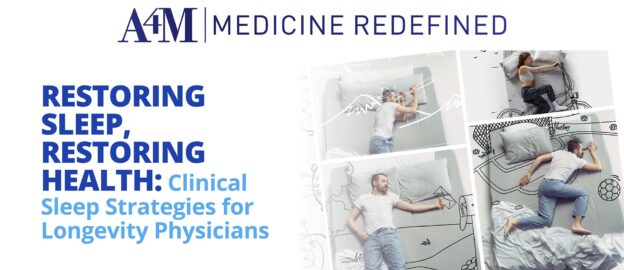Sleep isn’t a passive state, it’s a dynamic hormonal and neurological reset that shapes nearly every system involved in aging. For practitioners focused on extending healthspan, optimizing sleep may be the most underutilized therapeutic lever available.
With A4M’s upcoming “Restoring Balance” course, physicians have a unique opportunity to deepen their clinical skillset in one of the most physiologically powerful, yet clinically overlooked, domains of longevity medicine.
The Hormone-Sleep Axis: A Two-Way Circuit
The endocrine system and sleep architecture are in constant bidirectional conversation. Cortisol, melatonin, insulin, growth hormone, estradiol, and testosterone are all rhythmically entrained to the sleep-wake cycle. When circadian timing is disrupted, whether by stress, perimenopause, or screen-driven insomnia, so is hormonal output.
For example, evening cortisol elevation can blunt melatonin production, reduce REM sleep, and trigger morning fatigue. In menopausal women, declining progesterone often leads to sleep fragmentation and impaired slow-wave sleep, further exacerbating cortisol volatility and insulin resistance. These loops are not theoretical, they show up in patient labs, symptoms, and biometric wearables daily.
The takeaway for physicians: treating hormone imbalances in isolation may miss the root cause. The body restores hormonal balance during sleep. If that window is impaired, so is your intervention.
Insomnia as a Systemic Risk Factor
Insomnia is often treated as a standalone disorder, when in fact it’s a systemic signal of underlying dysfunction – metabolic, neurological, or inflammatory. Suboptimal sleep duration and quality elevate proinflammatory cytokines like IL-6 and CRP, impair glymphatic clearance of amyloid-beta, and worsen insulin sensitivity in as little as one week. In the aging population, chronic sleep loss is now directly linked to cognitive decline, cardiovascular disease, and accelerated biological aging.
This makes sleep optimization a core strategy for any physician practicing preventative or regenerative medicine. By restoring circadian harmony, clinicians can reverse pathologic loops that often go unrecognized in sleep-deprived patients with complex, multisystem complaints.
Practice Integration: Where to Begin
Clinicians can start by integrating sleep assessments into new patient intakes and annual labs. Evaluate circadian rhythm disruption using salivary cortisol curves or melatonin profiles. Track biometric feedback (HRV, sleep stages, overnight glucose trends) through validated wearables when possible. Where appropriate, consider pharmacologic or nutraceutical agents as bridge therapies, not crutches.
Most importantly, align lifestyle prescriptions with biology. Advise patients to anchor their circadian system: expose eyes to morning light within 30 minutes of waking, limit artificial light after sunset, and schedule meals and workouts to reinforce diurnal rhythms. These changes may seem small, but they can trigger profound improvements in endocrine balance, autonomic tone, and mitochondrial recovery.
Why Sleep Belongs at the Center of Longevity Medicine
As A4M’s Restoring Balance course will explore, sleep is not merely a behavior, it’s a biological infrastructure for health. It mediates hormonal cascades, cleans the brain, supports metabolic repair, and reduces epigenetic drift. For physicians seeking high-leverage, low-risk interventions that touch every aging pathway, sleep is not optional, it’s foundational.
Sleep optimization is not about prescribing rest, it’s about re-engineering the conditions for deep physiologic repair. And that begins with clinical education.
Source:

